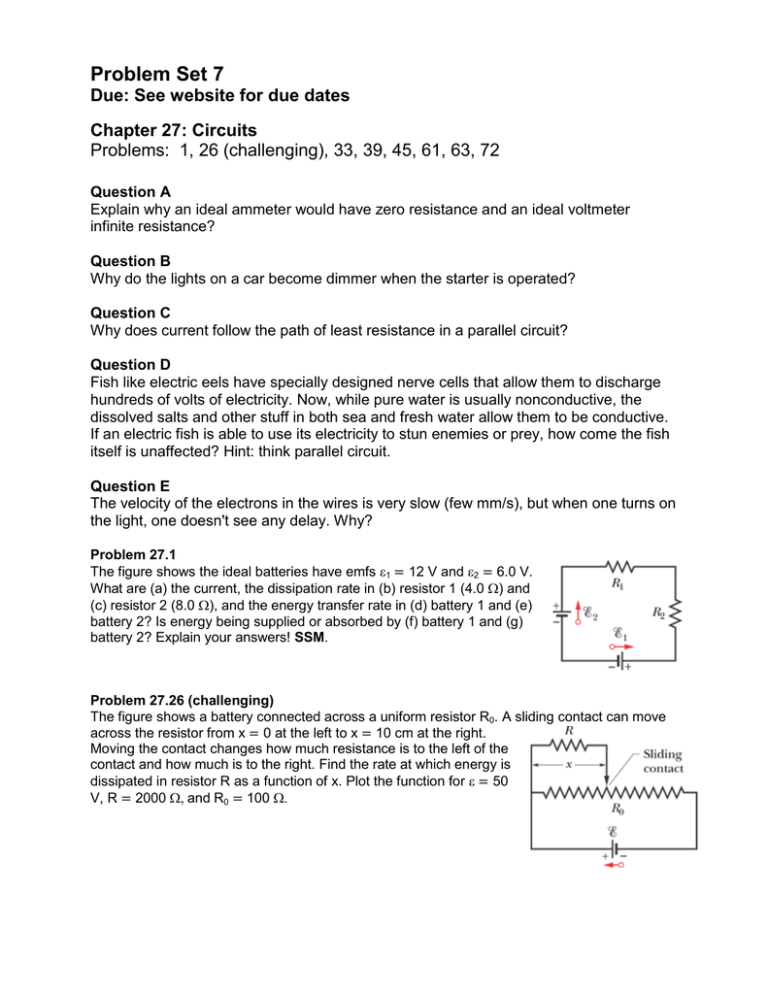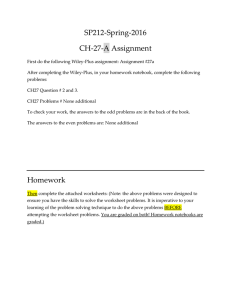Chapter 27: Circuits
advertisement

Problem Set 7 Due: See website for due dates Chapter 27: Circuits Problems: 1, 26 (challenging), 33, 39, 45, 61, 63, 72 Question A Explain why an ideal ammeter would have zero resistance and an ideal voltmeter infinite resistance? Question B Why do the lights on a car become dimmer when the starter is operated? Question C Why does current follow the path of least resistance in a parallel circuit? Question D Fish like electric eels have specially designed nerve cells that allow them to discharge hundreds of volts of electricity. Now, while pure water is usually nonconductive, the dissolved salts and other stuff in both sea and fresh water allow them to be conductive. If an electric fish is able to use its electricity to stun enemies or prey, how come the fish itself is unaffected? Hint: think parallel circuit. Question E The velocity of the electrons in the wires is very slow (few mm/s), but when one turns on the light, one doesn't see any delay. Why? Problem 27.1 The figure shows the ideal batteries have emfs 1 = 12 V and 2 = 6.0 V. What are (a) the current, the dissipation rate in (b) resistor 1 (4.0 ) and (c) resistor 2 (8.0 ), and the energy transfer rate in (d) battery 1 and (e) battery 2? Is energy being supplied or absorbed by (f) battery 1 and (g) battery 2? Explain your answers! SSM. Problem 27.26 (challenging) The figure shows a battery connected across a uniform resistor R0. A sliding contact can move across the resistor from x = 0 at the left to x = 10 cm at the right. Moving the contact changes how much resistance is to the left of the contact and how much is to the right. Find the rate at which energy is dissipated in resistor R as a function of x. Plot the function for = 50 V, R = 2000 andR0 = 100 Problem 27.33 In the figure, the current in resistance 6 is i6 = 1.40 A and the resistances are R1 = R2 = R3 = 2.00 , R4 = 16.0 , R5 = 8.00 and R6 = 4.00 . What is the emf of the ideal battery? Problem 27.39 In the figure, two batteries of emf = 12.0 V and internal resistance r = 0.300 are connected in parallel across a resistance R. (a) For what value of R is the dissipation rate in the resistor a maximum? (b) What is that maximum? Problem 27.45 In the figure, the resistances are R1 = 1.0 and R2 = 2.0 , and the ideal batteries have emfs 1 = 2.0 V and 2 = 3 = 4.0 V. What are the (a) size and direction (up or down) of the current in battery 1, the (b) size and direction of the current in battery 2, and the (c) size and direction of the current in battery 3? (d) What is the potential difference Va − Vb? Problem 27.61 A 15.0 kΩ resistor and a capacitor are connected in series, and then a 12.0 V potential difference is suddenly applied across them. The potential difference across the capacitor rises to 5.00 V in 1.30 μs. (a) Calculate the time constant of the circuit. (b) Find the capacitance of the capacitor. Problem 27.63 In the circuit, =1.2 kVC = 6.5FR1 = R2 = R3 = 0.73 M. With C completely uncharged, switch S is suddenly closed (at t = 0). At t = 0, what are (a) current i1 in resistor 1, (b) current i2 in resistor 2, and (c) current i3 in resistor 3? At t = (that is, after many time constants), what are (d) i1 (e) i2, and (f) i3? What is the potential difference V2 across resistor 2 at (g) t = 0 and (h) t = ? (i) Sketch V2 versus t between these two extreme times. SSM Problem 27.72 In the figure, the ideal battery has emf =30.0 Vand the resistances are R1 = R2 = 14 , R3 = R4 = R5 = 6.0 , R6 = 2.0 , and R7 = 1.5 . What are currents (a) i2, (b) i4, (c) i1, (d) i3, and (e) i5?





